RESEARCH AND DEVELOPMENT EXPENSES IN THE INDUSTRIAL SECTOR
Data aggiornamento scheda:
The 2022 update highlights the continued recovery of intramural Research and Development (R&D) expenditure by industrial enterprises, reaching €11.39 billion (+3.1% compared to 2021), surpassing for the first time the pre-pandemic peak of 2019. Almost all of this expenditure (98.9%) continues to be borne by the manufacturing sector, while the contribution of extractive activities, energy supply, and waste management services accounts for just 1.1%. Over the decade 2012–2022, total investment grew by more than a third (+36.6%), as shown in Table 1. When related to GDP, the share stood at approximately 1.31% in 2023 (1.37% in 2022), a level that keeps Italy below the euro area average and behind its main European industrial partners.
INDUSTRIAL ENTERPRISES
Data aggiornamento scheda:
The indicator measures the number of industrial enterprises in the strict sense, their local operational units, and the employed workforce, providing a snapshot of the national production structure and its evolution.
In 2022, the number of active enterprises in the industrial sector (in the strict sense) amounted to 390,580, a figure that remained essentially stable compared to 2021 (+0.02%). The territorial distribution remains polarized, with over half of the enterprises concentrated in the northern part of the country. In terms of employment, the number of workers totaled 4,137,637, marking a 1.5% increase compared to the previous year. Overall, the manufacturing sector remains the dominant component, accounting for over 90% of industrial employment.
ENVIRONMENTAL PROTECTION INVESTMENTS
Data aggiornamento scheda:
In 2022, gross fixed investments by industrial enterprises aimed at environmental protection suffered a dramatic collapse: the total value dropped from €1,454.3 million to €508.7 million, marking a contraction of approximately 65% compared to the peak reached just a year earlier. The downturn affected both “end-of-pipe” technologies (−71.5%) and integrated technologies (−47.6%) in a similar manner, so the share of integrated solutions in total investment remained essentially unchanged at just over 40%.
At the sectoral level, manufacturing remained the top investor with almost €300 million, although it reduced its outflows by more than half; electricity and gas lost most of the commitments made in 2021 (−87%), while water management settled at €125 million (−62%). Among CEPA categories, despite steep declines, “Wastewater Management” (€171.7 million) and “Air and Climate Protection” (€126.4 million) remained the most significant.
INDUSTRIAL PRODUCTION INDEX
Data aggiornamento scheda:

The Industrial Production Index (IPI) describes the trend of industrial activity (in the strict sense) in Italy through the monthly survey of actual production volumes. The level of industrial production is a key factor closely related to environmental pressures. After diverging during the 2010–2013 period, industrial production trends in Italy have aligned with those of the main European industrial countries and the euro area average (while remaining higher). In 2020, the index hit the historical minimum (93.3) due to COVID-19 containment measures, which led to the closure or strong restriction of production activities. The industrial production rebound in 2021 (104.7) was stronger than in France and Germany but was outpaced by the euro area average. After stagnating between 2021 and 2022 (105.1), the index declined again in 2023 (102.5). The medium- to long-term trend remains positive: in 2023, the index gained 2.5 percentage points compared to the base year 2015. The “capital goods” group showed the highest year-over-year increase (15.5 percentage points), while mining activities experienced a sharp decline (-31.6 p.p.). Nearly all variability in industrial production over time is explained by changes in manufacturing activity volumes.
CARBON DIOXIDE EMISSION INTENSITY IN THE CHEMICAL INDUSTRY
Data aggiornamento scheda:
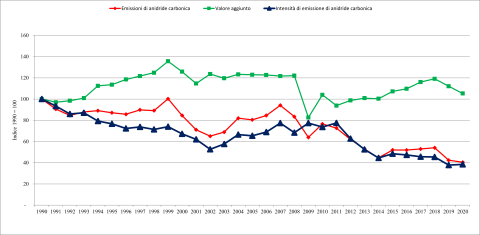
The carbon dioxide (CO₂) emission intensity related to energy use in the Italian chemical industry is analysed in relation to the sector's value added. In 2020, the indicator increased by 1.7% compared to 2019, although it decreased by 61.5% relative to 1990. The data, covering the period 1990–2020, are reported annually to the European Commission as part of the greenhouse gas emission monitoring mechanism and in implementation of the Kyoto Protocol.
CARBON DIOXIDE EMISSION INTENSITY IN THE STEEL INDUSTRY
Data aggiornamento scheda:
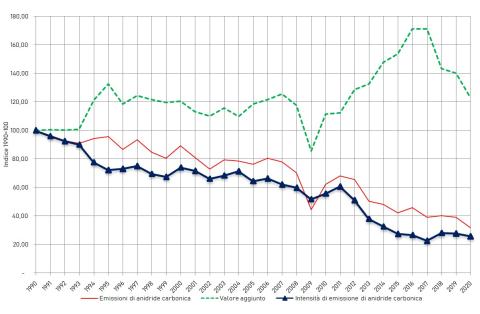
This section presents the carbon dioxide emission intensity in the steel industry in Italy, analyzed with respect to both the sector's value added and steel production. Over the period from 1990 to 2020, a decrease of 74.3% in value added and 60.4% in steel production is recorded. These indicators, developed for the period 1990-2020, are communicated annually to the European Commission as part of the Community's greenhouse gas monitoring mechanism and for the implementation of the Kyoto Protocol during the commitment periods. CO2 emissions from the steel industry decreased by 68.3% from 1990 to 2020. In 2020, emissions decreased by 18.55% compared to the previous year.
PRTR REGISTER: WATER EMISSIONS (FORMERLY INES REGISTER: WATER EMISSIONS)
Data aggiornamento scheda:

The EPRTR (European Pollutant Release and Transfer Register) is the integrated register established by the EU based on Regulation (EC) No. 166/2006, aimed at making publicly available information on environmental impacts caused by industrial facilities falling under the criteria set out in the regulation.
This indicator represents total emissions into surface waters and pollutant transfers in wastewater from industrial facilities that reported such data to the national PRTR register. For the year 2020, 60 substances were reported as present in emissions into surface water bodies, while 49 substances were declared in pollutant transfers via wastewater conveyed through pipelines to external treatment facilities.
The PRTR activity groups that contribute the highest percentages of reported pollutant emissions into both wastewater and surface waters are generally those related to "Waste and Wastewater Management" and "Chemical Industry".
PRTR REGISTER: NUMBER OF FACILITIES AND PRTR ACTIVITIES (PREVIOUS INES REGISTER: NUMBER OF FACILITIES AND IPPC ACTIVITIES)
Data aggiornamento scheda:

The European Pollutant Release and Transfer Register (EPRTR) is the integrated register established by the EU, based on Regulation (EC) No. 166/2006, with the aim of making available to the public information on the environmental impacts caused by industrial establishments that meet the criteria specified by the regulation. In 2020, the industrial sources responsible for most emissions to air and water were 4,127, of which 3,148 are located in the North, 523 in the Centre, 450 in the South and Islands, and 6 in the sea. The number of declared PRTR activities is 5,086. Generally, the total number of declared PRTR activities is always greater than the number of declarations received, as one establishment can carry out one or more PRTR activities.
CARBON DIOXIDE EMISSION INTENSITY IN INDUSTRY RELATIVE TO VALUE ADDED
Data aggiornamento scheda:
The efficiency indicator, calculated for the years from 1990 to 2020, represents carbon dioxide emissions per unit of value added in the manufacturing and construction sectors in Italy. The substantial reduction in emission intensity over the years (-48% between 1990 and 2020) indicates an improvement in the level of efficiency achieved by the Italian manufacturing and construction industry.
SPECIFIC EMISSIONS FROM PRODUCTION PROCESSES IN THE CHEMICAL INDUSTRY
Data aggiornamento scheda:
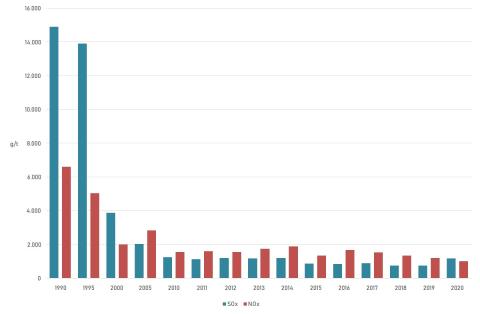
The indicator relates the total emissions into the atmosphere generated by production processes in the chemical and petrochemical sectors to the total quantity produced, in order to evaluate the specific emissions generated by the production of a single unit of product. In 2020, compared to 2019, the specific emissions of NOx decreased by 16%, SOx emissions increased by 58%, while specific emissions of NMVOCs and CO showed reductions of 3% and 8% respectively.
SPECIFIC EMISSIONS FROM PRODUCTION PROCESSES IN THE NON-FERROUS METALS INDUSTRY
Data aggiornamento scheda:
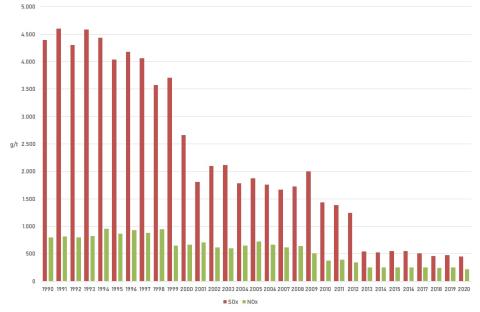
The indicator relates the total atmospheric emissions generated by the production and processing of non-ferrous metals to the total quantities produced, in order to assess the specific emissions per unit of product. Between 1990 and 2020, data analysis shows a significant reduction in specific emissions for all substances, with the exception of NMVOCs, which increased. This macrotrend is reflected in the year-over-year change: in 2020 compared to 2019, while the specific emissions of CO, NOx and SOx decreased, those of NMVOCs slightly increased.
CARBON DIOXIDE EMISSION INTENSITY IN THE PAPER INDUSTRY
Data aggiornamento scheda:

This section presents the carbon dioxide (CO₂) emission intensity related to energy use in the paper and printing industry in Italy, analyzed both in relation to value added and to production volume. In 2020, compared to the previous year, emission intensity per unit of production decreased by 2.2%, while intensity per unit of value added increased by 2.7%. In terms of long-term trends since 1990, the indicator—calculated both by value added and production—shows a general increase. This indicator, covering the period 1990–2020, is reported annually to the European Commission as part of the EU greenhouse gas emissions monitoring mechanism and the implementation of the Kyoto Protocol.
CARBON DIOXIDE EMISSION INTENSITY IN THE NON-METALLIC MINERAL PROCESSING INDUSTRY
Data aggiornamento scheda:

The carbon dioxide (CO₂) emission intensity related to energy use in the non-metallic mineral processing industry in Italy is presented here, analyzed with reference both to the sector’s value added and to cement production. CO₂ emissions from energy processes in this industry decreased in absolute terms by 50.8% from 1990 to 2020. Over the same period, emission intensity per million euros of value added fell by 27.5%. These indicators, developed for the 1990–2020 period, are reported annually to the European Commission as part of the EU’s greenhouse gas emissions monitoring mechanism and for the implementation of the Kyoto Protocol during commitment periods.
PRTR REGISTER: AIR EMISSIONS (FORMERLY INES REGISTER: AIR EMISSIONS)
Data aggiornamento scheda:
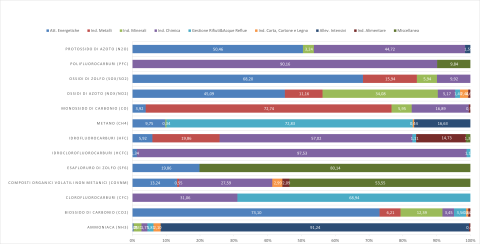
The EPRTR (European Pollutant Release and Transfer Register) is the integrated register developed by the EU under Regulation (EC) No 166/2006, with the aim of making publicly available information on environmental impacts from industrial facilities that meet the criteria established in the legislation. This indicator represents the total air emissions from industrial facilities that have reported such emissions to the national PRTR register. The air emissions declared for 2020 refer to 34 substances (non-zero values). Comparing 2020 data with 2007, it is observed that for 25 substances, total national atmospheric emissions have decreased (for 23 of these, reductions exceed 40%), while for 8 substances, overall emissions have increased (including: hydrogen cyanide +356% from 2007, hydrofluorocarbons +19%, and ammonia +109%).
PRTR REGISTER: OFF-SITE WASTE TRANSFER
Data aggiornamento scheda:

EPRTR (European Pollutant Release and Transfer Register) is the integrated register established by the EU pursuant to Regulation (EC) No. 166/2006, aimed at making available to the public information regarding environmental pressures from industrial facilities falling within the scope of the regulation.
This indicator represents the quantities of hazardous and non-hazardous waste generated by industrial facilities that have reported such data to the national PRTR register.
Regarding "industry" data on hazardous waste, in 2020, the PRTR groups that transferred the largest amounts of hazardous waste across borders were the metal industry, the chemical industry, and energy-related activities. The total amount of hazardous waste exported by the industrial sector in 2020 accounted for 1.7% of all hazardous waste transferred by “industry”.
Facilities categorized under “Waste and wastewater management” also exported hazardous waste in 2020: about 24.65% of the hazardous waste declared by this group was sent abroad.
SPECIFIC EMISSIONS FROM PRODUCTION PROCESSES IN THE PAPER INDUSTRY
Data aggiornamento scheda:

The indicator relates the main overall atmospheric emissions generated by production processes in the paper industry to the total amount of paper produced, in order to assess the specific emissions generated. Compared to the previous year, the specific emissions of all pollutants remained stable in 2020, with the exception of sulphur oxides emissions, which increased by 6.2%. Compared to 1990, however, there was a decrease of 98.8% in sulphur oxides, 99.8% in NMVOCs, and more moderate decreases in nitrogen oxides (-2.6%) and PM10 (-8.5%).
SPECIFIC EMISSIONS FROM PRODUCTION PROCESSES IN THE NON-METALLIC MINERAL INDUSTRY
Data aggiornamento scheda:
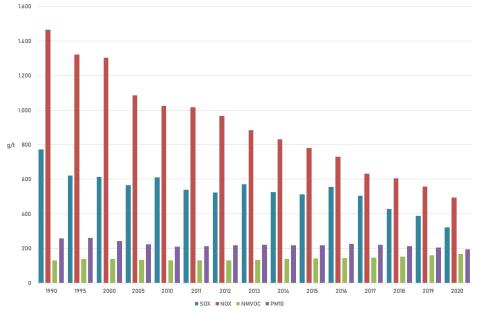
The indicator relates the total atmospheric emissions generated by the production processes of the non-metallic mineral industry sector to the total quantities produced, in order to assess the specific emissions associated with the production of one unit of product. In 2020, compared to 2019, the specific emissions of all substances considered decreased, except for NMVOCs, which showed a slight increase.
SPECIFIC EMISSIONS FROM PRODUCTION PROCESSES IN THE STEEL INDUSTRY
Data aggiornamento scheda:
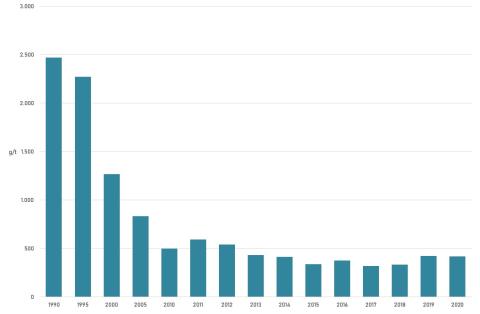
The indicator relates the total atmospheric emissions generated by production processes in the steel sector to the total amount of steel produced, in order to assess the specific emissions generated per unit of steel production. Between 2019 and 2020, all considered substances show a slight decrease. The magnitude of fluctuations in recent years, starting from 2012–2013, is modest.